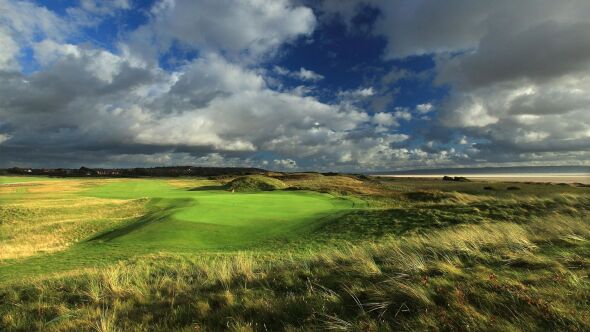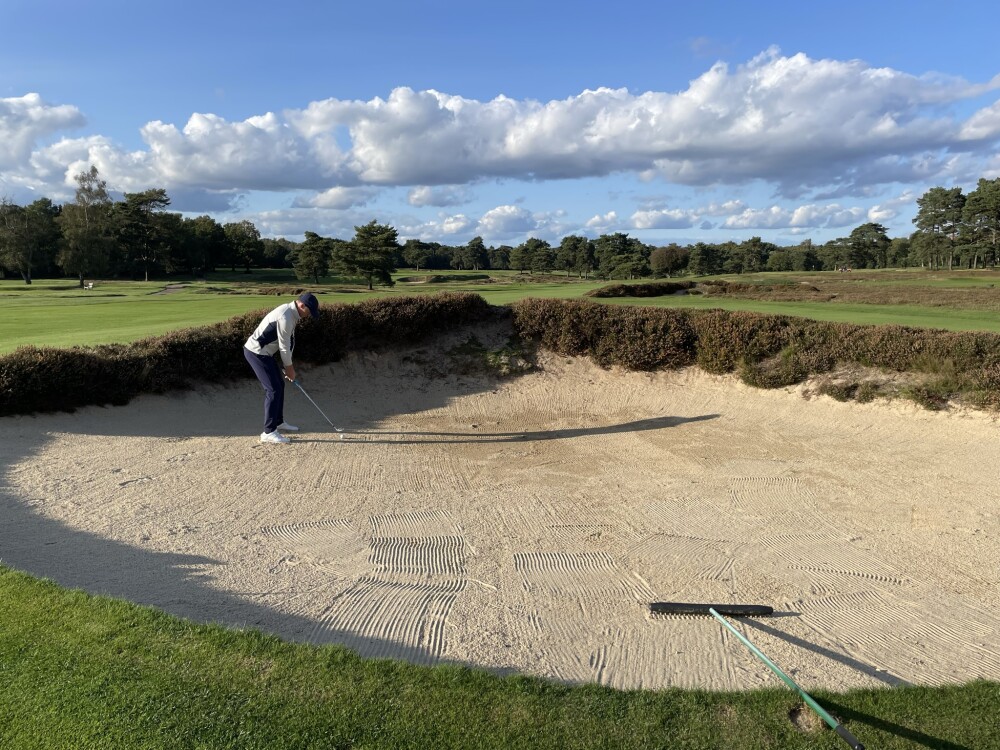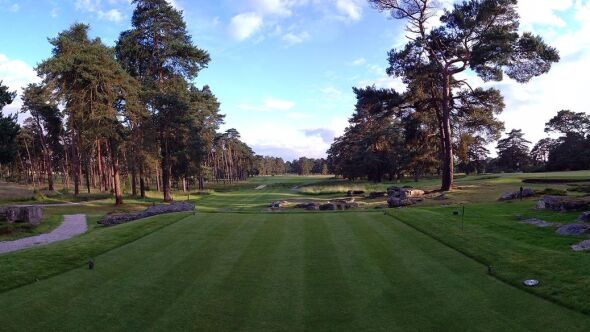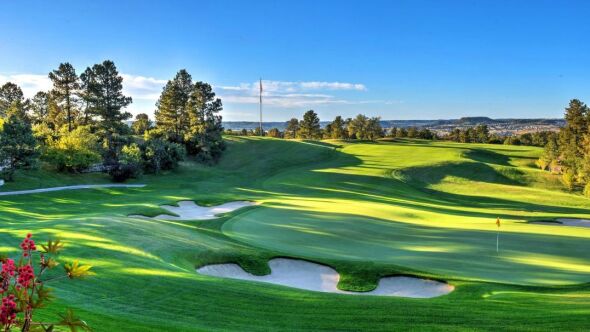Let's get one thing clear before we start debating which types of golf courses are the hardest.
The correct answer is all of them. Golf is hard, period. At various points in the planning stages of this story, I had three different styles of golf courses ranked as the most difficult.
Thinking about which type of golf course is most resistant to scoring - the five most common are links, parkland, heathland, desert and mountain - brought flashbacks of rounds where I was truly humbled by the game. If you were paired with me at Sunningdale and Walton Heath (both heathland courses), Royal County Down (links), Oak Hill (parkland), Grayhawk (desert) or the Broadmoor (Mountain), let me apologize in perpetuity. These tournament venues generally take my meager, one-dimensional skills to task.
I could have also included some other course styles - Sandbelt, clifftop and jungle courses, for example - but I stuck with the five most recognizable. All of them boast elements of target golf, which, in my opinion, is the hardest style of golf for most amateurs to execute on a shot-by-shot basis. Target golf requires equal parts consistency, accuracy and quality decision-making to plot one's way around a course. A mistake in any of those three aspects generally leaves your ball in a horrible lie or, worse, a penalty drop after being lost. If I'm being truthful, I find Florida and South Carolina's Lowcountry the hardest regions of the country to play golf in, generally speaking. You're constantly forced to avoid water, marsh and other ball-swallowing hazards, not to mention the bunkers and trees. Hitting out of temperamental Bermuda rough and putting on grainy Bermuda greens adds to the difficulty.
What's also interesting about this debate is most golfers grow up playing a certain type of golf course, but struggle to adjust to something different. If you learned the game on a links, for example, you probably have a better-than-average grasp of the bump-and-run or the 30-yard putt from off the green. Those shots are less useful elsewhere.
You're probably not going to agree with my rankings, but this is a good thought exercise to better understand your own game. Maybe this argument will help you figure out what courses to play to best fit your strengths or motivate you to take that golf trip to the mountains or the desert to try your hand at a style of golf you're unfamiliar with playing. By the way, GolfPass offers golf packages to all of these types of courses.
Which style of golf do you find the easiest or the hardest? Let us know in the comments below.
-
Links golf courses
After a blind shot from the ninth tee, golfers trudge up a dune to reveal this spectacular view at Royal County Down Golf Club. Getty Images Defining links golf: The term "links" describes courses that were built on sandy soil that was the "link" between farmland and the sea. Since crops couldn't grow, golf became the perfect use for what was otherwise worthless land. Scotland, Ireland and England are home to most of the world's links, but there are other pockets in places like Oregon and New Zealand.
Why links golf is hard: What's so hard about links golf? I love it. I proudly boast that I was born on the wrong side of the pond, because hitting low, straight shots that bounce for days and stay out of the wind is my specialty.
I realize, though, that for the majority golfers, links golf is as foreign a concept as calculus. Most golfers play 'swing', where they hit high shots that land near the target they intended. Links golf requires more strategy and creativity. You're not just battling the course. You're battling the elements. All links golf courses, by definition, are on or near the water, so cooler temperatures, wind strength and direction and the likelihood of rain are constant threats to your score.
Based on those factors, 165 yards might play vastly different from one hole to the next. Are you playing a low-running punch 6 iron into the wind or a high-flying 9 iron that rides the breeze?
The hazards of links golf feel more penal than other courses. Blind shots tend to make golfers very nervous. Bunkers on links courses tend to be deeper and more intimidating, sometimes with revetted faces more than 10 feet high. They also seem to have magical powers of attraction, sucking shots in like a magnet. A drive smashed down the middle of the fairway can sometimes hit a bump in the ground and careen into a fairway bunker so deep that only a sideways shot can escape.
Lies after missing a shot into the dunes tend to unpredictable as well. The ball could be perfectly fine or lost forever in a gorse bush. It's the "rub of the green," where weird bounces and fickle lies are commonplace, that makes playing links golf so mesmerizing and maddening at the same time.
Hardest links I've played: Royal County Down, Royal St. Georges, Ballybunion Old.
Other famous links golf coursesCarnoustie, AngusPublic/Resort -
Desert golf courses
The 15th hole is the longest of the par 3s on the Saguaro Course at We-Ko-Pa Golf Club in Scottsdale, Arizona. Brandon Tucker/Golf Advisor Defining desert golf: Desert courses are as the name suggests - layouts built in a desert environment, where sand, rocks, cacti and a barren landscape dominate the surroundings.
Why desert golf is difficult: Here's where my target golf theory comes into play. Desert golf feels most like target golf. Seeing a sliver of green fairway bracketed by all that brown dirt and prickly cacti tends to paralyze average golfers with fear. Once it's in your head that your ball could go into the desert, where poisonous scorpions and rattlesnakes lurk, you're toast mentally. Uncertainty is the worst kind of swing thought. Who needs bunkers when the entire landscape is one giant sand trap?
Because it's expensive to maintain playable turf in the desert, most courses in Arizona, California and Nevada have an abnormal amount of forced carries off the tee or on the approach. This is where my game struggles, hitting solid shots that carry trouble. If there's a hazard I need to worry about, I'm probably going to be in it, along with several other players in my foursome, too.
Desert golf also tends to be hot, and the hardest place to actually grow grass naturally and maintain quality conditions. If you're lucky enough to only play during snowbird months from January through the end of March, you get the best of the climate and the conditions. The locals are the ones who have to deal with the transitional months when the overseeding is either being applied in the fall or scraped away in the spring. And who's crazy enough to play in the 100-degree heat of summer? My golf-mad colleague Tim Gavrich, that's who. No thanks. I'll stick to umbrella drinks by the pool over a sweaty, uncomfortable round in excessive heat any day.
Hardest desert courses I've played: PGA West Stadium, TPC Scottsdale Stadium, Desert Mountain Geronimo.
Other famous desert golf courses -
Heathland golf courses
The fairway bunkers on Walton Heath Golf Club's Old Course are dangerous. They're not only deep but lined with heather. Jason Scott Deegan/GolfPass Defining heathland golf: The word "heath" describes "an area of open, uncultivated land, especially in Britain, with characteristic vegetation of heather, gorse and coarse grasses." A heathland golf course plays like a hybrid of a parkland - it also sports trees, bunkers and ponds - and a links, mainly because of its firm, bouncy, sandy terrain and the fact that an off-line tee shot into the heather or gorse is the biggest hazard.
Why heathland golf is hard: My original choice for No. 1 was heathland golf, all based on my first experience playing golf around London last year. Then I reconsidered, taking into account that I had simply brought my 'C' game.
What I found so unnerving about heathland golf was the fact that every fairway felt U.S. Open-narrow. The heather was so penal. The fact that I could always find the ball in the thick stuff didn't feel like an advantage. This would merely tempt me into hitting a recovery shot that failed more often than not. I had to start playing more conservative and learn a new swing - a steep, violent chop out - just to nudge my misses back into play (sometimes).
Add in the trees, the firm turf that bounces like a links, the bunkers (which I found to be generally deeper and more penal than parkland courses) and I was powerless against London's premier tournament venues. Both Walton Heath (2023 AIG Women's Open) and Sunningdale (2024 Curtis Cup) have hosted high-profile events recently, so I shouldn't be surprised I didn't shoot my handicap until I went to a slightly more playable heathland like West Hill.
Hardest heathland courses I've played: Sunningdale New, Walton Heath Old and New.
Other famous heathland golf coursesSunningdale, Windsor and MaidenheadSemi-PrivateWoodhall Spa, East LindseyPrivate -
Mountain golf courses
Primland Resort, hidden in the Blue Ridge Mountains in southern Virginia, can be a great spot for viewing autumn's changing of the leaves. Courtesy of Primland Defining mountain golf: Man has been battling mountains for centuries, always trying to reach the summit, whether it's with a pick axe or golf club in hand. Virtually any golf course designed in a mountainous region, usually above 2,000 feet in elevation, can be labeled as a mountain course, although the truest form of the genre is a course that rides the elevation changes of rugged, natural terrain that makes the game incredibly scenic but also distinctly difficult.
Why mountain golf is hard: I thoroughly enjoyed watching the pros play the 2024 BMW Championship, the first PGA Tour event at Castle Pines outside of Denver in almost 20 years. The course had to be lengthened to 8,000+ yards - the longest in PGA Tour history - to contain their prodigious length, but even with a caddie, they struggled picking the right club. They were flying wedges over the greens and generally dumbfounded trying to figure out the math that mountain golf at elevation requires. How far will this shot fly and how will the downhill fall or uphill climb impact the distance necessary to be accurate?
Mountain golf, by nature, also provides the challenge that befuddles amateurs most - how to achieve consistent contact from uphill, downhill or sidehill lies. Only the best ball strikers seem to have the ability to figure this out. The rest of us just hit and hope, especially when trying to carry a ravine from a crooked lie.
Golf season in the mountains tends to be shorter, so in shoulder season you're also contending with less-than-ideal conditions and temperatures that fluctuate throughout the day.
Hardest mountain courses I've played: The Reserve at Moonlight Basin, Sugarloaf, Broadmoor East.
Other famous mountain golf courses -
Parkland golf courses
![The Olympic Club - Lake Course - clubhouse views of the 18th hole]()
The clubhouse view down to the 18th hole of The Olympic Club's Lake Course is incredible. Jason Scott Deegan/GolfPass Defining parkland golf: Parkland golf courses are built inland away from large bodies of water in settings that look like you're playing golf in a park. There are trees and ponds with golf course architects adding bunkers to create the most common theater for the game.
Why parkland golf is hard: I believe parkland golf is the easiest form of golf for one reason: it's generally one-dimensional. Golfers who can hit it far can generally excel playing parkland golf much faster than the other forms of golf course architecture. Sure, there are bunkers, ponds, trees and rough as obstacles, but those can all be avoided with good ball striking or sound decision-making.
The modern movement to remove trees and open up driving corridors has made parkland golf even more straightforward a test of one's skills. Gone are the narrow, tree-lined fairways, unless you're playing somewhere like Sahalee in the Pacific Northwest.
A parkland course's best defenses, as the United States Golf Association has shown time and again at the U.S. Open, is to narrow the fairways with knee-high rough and firm up the fairways and greens, so the ball bounces into trouble at every turn. Thankfully, most superintendants at public parkland courses around America keep things playable for everyday golfers.
Hardest parklands I've played: Le Golf National, Bethpage Black, Oak Hill East.
Other famous parkland golf coursesPinehurst, North CarolinaResortVirginia Water, Runnymede Borough CouncilResort/Private

 Back
Back































































Comments (2)
Any course that has lots of blind shots is the toughest for me. Those also aren't very fun because it's borderline unfair to not give the golfer a target. It's even worse if you've never played the course previously.
Great, perceptive article with lots of solid evidence to support your choices.
Yes, all golf courses are tough, and ultimately rating one variety for toughness over another is, finally, a subjective exercise. I believe that links
is categorically the toughest brand of golf. Not only are they difficult when the atmosphere is merely breezy, but they often become downright murderous when the wind strength turns moderate to strong. In these cases, breaking 85 on a challenging links turns into a true achievement. Everything else you point out about the difficulties of links golf (including various whims, odd lies, and the necessity of choosing strategic options) is, as the Brits say, “spot-on.” I would rank mountain golf as the second toughest form of golf, primarily because the uphill slopes can be so daunting and for the resultant tendency to make already lengthy par-4s seem to play instead as if they’re 500 yards long. Big hills with substantial curvature can also make for some unpredictable or even wild bounces.
I give credit to your colleague Mr. Gavrich for sticking it out in 100-degree desert courses. Does that make him a madman? Nah.